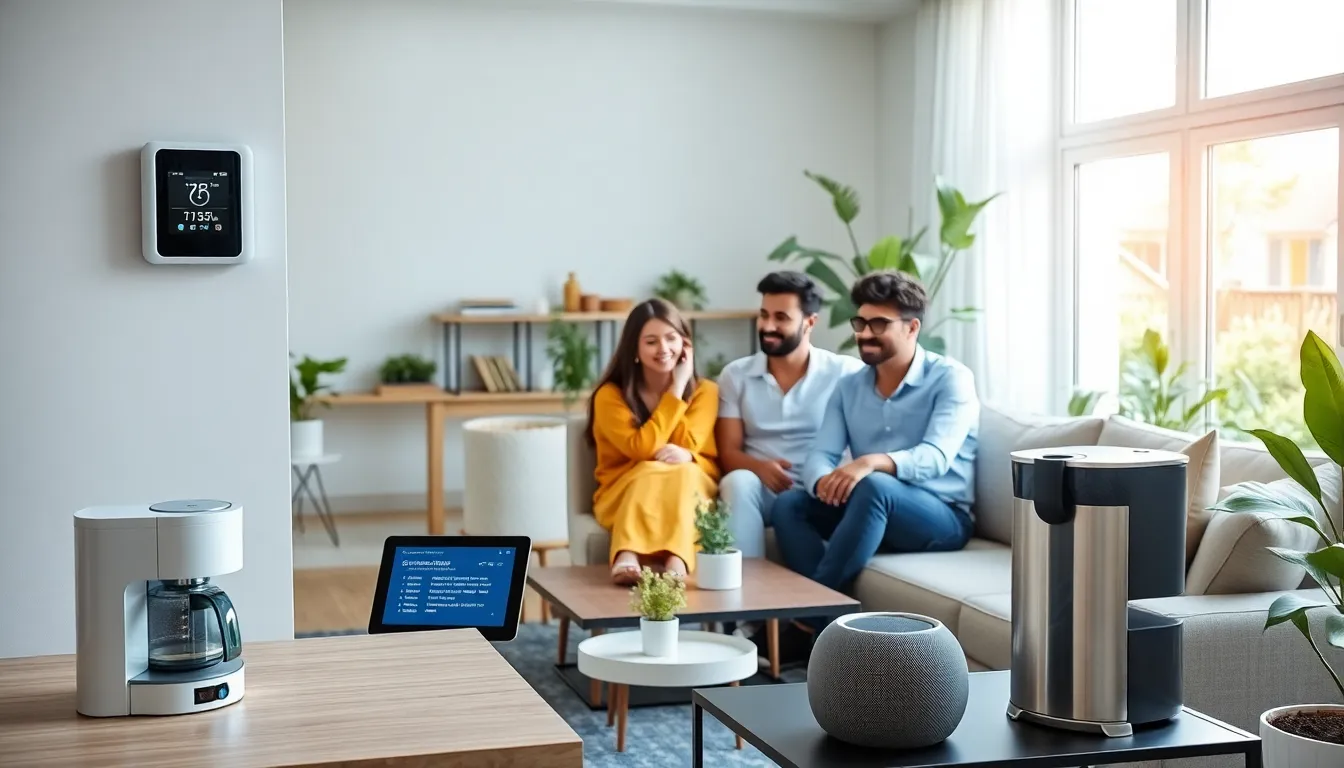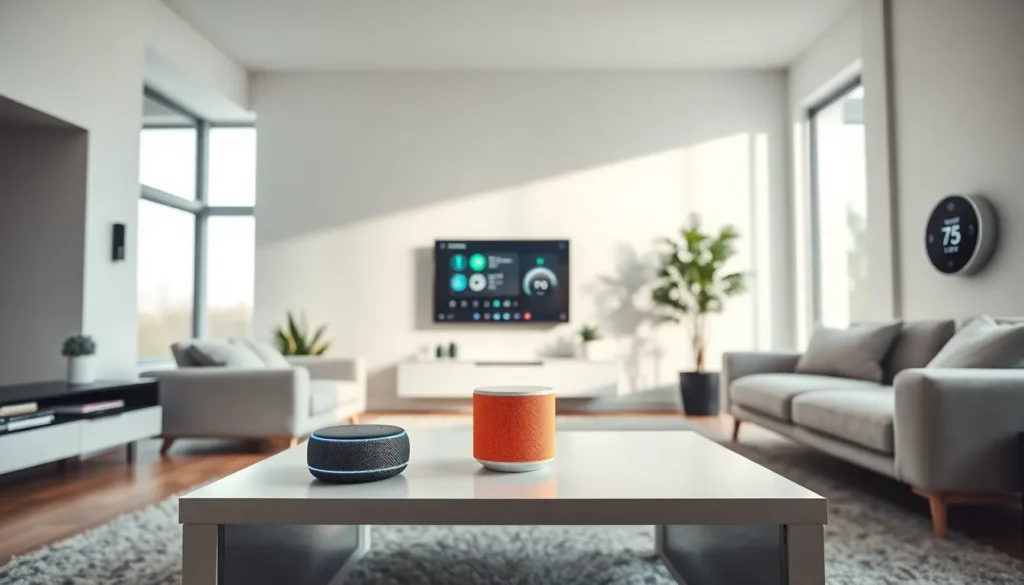Table of Contents
ToggleImagine walking into your home and having the lights automatically dim as your favorite playlist begins to play. Sounds dreamy, right? This scenario is quickly becoming a reality, thanks to IoT smart homes. Forget about the mundane, welcome to the future, where your fridge knows when you’re out of milk, and your thermostat adjusts based on your mood. This article explores how the Internet of Things transforms our living spaces into smart havens that are not only convenient but also efficient. Buckle up: we’re about to jump into the delightful world of connected living.
Understanding IoT and Its Role in Smart Homes

The Internet of Things (IoT) refers to the network of physical devices, vehicles, and everyday objects embedded with sensors, software, and connectivity to enable data exchange. In essence, it allows these devices to communicate and interact with each other and the broader internet.
In a smart home, IoT technology plays a crucial role. It transforms traditional household items into smart gadgets. Think about your coffee maker that starts brewing just as your alarm goes off, or your security system that sends real-time alerts straight to your smartphone. These innovations create a seamless living experience, enhancing convenience and efficiency.
Eventually, embracing IoT is not merely about having fancy gadgets: it’s about crafting a lifestyle where technology enriches everyday routines, making them smoother and smarter.
Benefits of an IoT-Enabled Smart Home
An IoT-enabled smart home isn’t just a trend: it’s a revolution in how individuals manage their daily lives. Here are several key benefits:
- Convenience: One of the most significant advantages is convenience. Homeowners can control multiple devices from a central hub or their smartphones. Imagine adjusting your thermostat without getting up from the couch.
- Energy Efficiency: Smart homes optimize energy consumption. Devices can analyze patterns and automatically adjust settings for maximum efficiency. This means potential savings on energy bills.
- Enhanced Security: With smart security cameras and alarms, homeowners can monitor their property in real-time, no matter where they are. This level of oversight brings peace of mind.
- Customization: IoT systems can be tailored to individual preferences. Whether it’s your morning routine or controlling your sleep environment, customization options empower users.
- Integration: Seamless communication between devices means they can work together creatively. For instance, the smart lights can dim when the smart television turns on.
Key Devices in an IoT Smart Home
The world of IoT smart homes is filled with innovative devices that make life easier and more efficient. Here are some key players in this tech-savvy revolution:
- Smart Thermostats: These devices learn your heating and cooling preferences, adjusting automatically for comfort. They can be controlled remotely too.
- Smart Lighting: Controlled via smartphone apps or voice commands, smart lights can change colors and brightness levels, helping set the mood in any room.
- Smart Security Cameras: Offering real-time video feeds and alerts, these cameras enhance home security. Homeowners can monitor their property from anywhere, providing peace of mind.
- Smart Speakers: Acting as a central hub, these devices let users control other smart devices and retrieve information via voice commands. They are the ultimate multitaskers.
- Smart Appliances: Imagine a refrigerator that alerts you when you’re running low on groceries or a washing machine that you can start from your work. Smart appliances represent the future of household chores.
Security Considerations for IoT Smart Homes
While IoT smart homes boast convenience, there are notable security concerns to address. As more devices connect to the internet, the risk of cyber attacks increases. Here are some critical security considerations:
- Use Strong Passwords: Each smart device should have a unique, strong password. Avoid using defaults, as they are easily hackable.
- Regular Software Updates: Keeping device firmware up to date ensures that the latest security patches are applied, reducing vulnerabilities.
- Network Segmentation: Separating IoT devices from primary networks can limit exposure to potential threats, offering an additional layer of security.
- Monitor Device Activity: Regular monitoring can help spot unusual activity. If a device behaves strangely, it might indicate a security breach.
- Educate Yourself: Stay informed about the latest security practices and updates in IoT technology. Knowledge is a powerful tool for prevention.
Integrating IoT Devices: Challenges and Solutions
Integrating IoT devices in a household setting can be rewarding, yet challenges often arise. Below are some common hurdles and proposed solutions:
- Compatibility Issues: Not all devices are compatible with each other, causing frustration for users. Opting for devices that adhere to common standards or work with central hubs can help mitigate these issues.
- Complex Setup: Some devices require intricate setups, which can be daunting. Manufacturers now offer user-friendly instructions and online support to assist users during installation.
- Signal Interference: Wi-Fi connectivity can become unstable with multiple devices connected. Consider using a mesh network system to enhance signal strength and consistency throughout your home.
- Overwhelming Choices: The plethora of available devices can lead to analysis paralysis. Researching top-rated options and user reviews can guide newcomers in making informed choices.
- User Adoption: Some household members may resist technology. Demonstrating how IoT devices simplify tasks can encourage adoption among family members.
The Future Trends in IoT Smart Home Technology
Looking forward, the trends in IoT smart home technology paint a picture of a progressively connected living environment:
- Increased AI Integration: Artificial Intelligence will play a pivotal role in personalizing experiences at home. Expect devices to learn and adapt to user habits more efficiently.
- More Energy-Efficient Solutions: As climate awareness grows, energy-efficient IoT products will become the norm. Innovations focused on sustainability will dominate the market.
- Voice-Activated Devices: The demand for hands-free control will boost voice-activated devices, making interactions even simpler.
- Wearable Integration: Wearables will connect with home systems, allowing seamless control through health and fitness data. Imagine your home adjusting temperature based on your comfort levels.
- Interoperability Efforts: There will be a concerted effort towards developing universal standards that ensure devices from different brands work seamlessly together.




